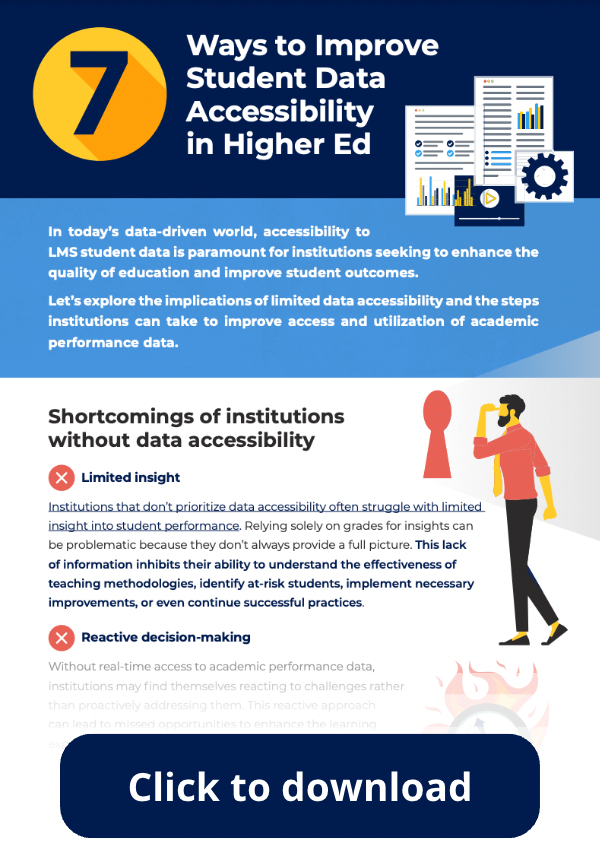In today’s data-driven world, accessibility to LMS student data is paramount for institutions seeking to enhance the quality of education and improve student outcomes.
Any institution’s accessibility to data depends greatly on that school’s data maturity. While some institutions can access comprehensive data, including real-time academic performance metrics, others are limited to basic information such as semester grades, which leads to reactive decision-making based on incomplete information.
Let’s explore the implications of limited data accessibility and the steps institutions can take to improve access and utilization of academic performance data.
Shortcomings of institutions without data accessibility
Limited insight
Institutions that don’t prioritize data accessibility often struggle with limited insight into student performance. Relying solely on grades for insights can be problematic because they don’t always provide a full picture. This lack of information inhibits their ability to understand the effectiveness of teaching methodologies, identify at-risk students, implement necessary improvements, or even continue successful practices.
Reactive decision-making
Without real-time access to academic performance data, institutions may find themselves reacting to challenges rather than proactively addressing them. This reactive approach can lead to missed opportunities to enhance the learning experience and improve overall student outcomes.
Why you need better academic performance accessibility
Informed decision-making
Accessible academic performance data allows institutions to make data-driven decisions. Whether it’s curriculum enhancements, resource allocation, or strategic planning, having real-time insights into student performance enables administrators to make informed choices that positively impact the overall quality of education.
Early identification of challenges
Transparent access to academic data enables institutions to identify challenges early on. By tracking student performance trends, institutions can proactively address issues such as high attrition or struggling students, in an effort to implement tailored interventions for improving overall student success rates.
What does better student data accessibility look like in higher ed?

There are seven ways institutions can improve student data accessibility:
- Implement a unified data management system
- Establish data governance policies
- Provide user-friendly data dashboards
- Foster a culture of data literacy
- Enable access to personalized data
- Utilize predictive analytics
- Regularly evaluate and update data systems
1. Implement a unified data management system
Invest in a comprehensive data management system that consolidates academic performance data from various sources. This unified system streamlines data collection, ensuring accuracy and accessibility for administrators, faculty, and students.
2. Establish data governance policies
Develop clear data governance policies to ensure responsible data management and security. These policies should define who has access to what data, establish data quality standards, and outline procedures for data updates and maintenance.
3. Provide user-friendly data dashboards
Create user-friendly data dashboards that offer a visual representation of academic performance metrics. Intuitive dashboards make it easier for administrators, faculty, and students to interpret and act upon the data.
4. Foster a culture of data literacy
Promote data literacy among faculty and staff by providing training sessions on interpreting and utilizing academic performance data. Provide a data dictionary as well to provide users with better terminology to express what they see or are looking for in data. A data-literate culture encourages proactive decision-making based on real-time insights.
5. Enable access to personalized data
Empower users by giving them access to personalized academic performance data. This transparency permits tracking student progress, identifying areas for improvement, and establishing ownership across the learning journey.
6. Utilize predictive analytics
Implement predictive analytics tools to forecast student performance trends and identify potential academic risks. These tools can help institutions intervene early and provide targeted support to at-risk students.
7. Regularly evaluate and update data systems
To ensure ongoing effectiveness, regularly evaluate and update data systems. Stay current with technological advancements, address any issues, and continuously improve data accessibility to meet evolving institutional needs.
How to get better access to student data
A comprehensive solution like Scaffold DataX offers institutions the means to implement all seven methods for enhancing student data accessibility in one tool. By providing better access to student data, DataX empowers institutions to analyze opportunities to identify risk and create tailored retention plans. Schedule a free demo with a data integration solution expert to see first-hand if DataX would be right for your institution.







